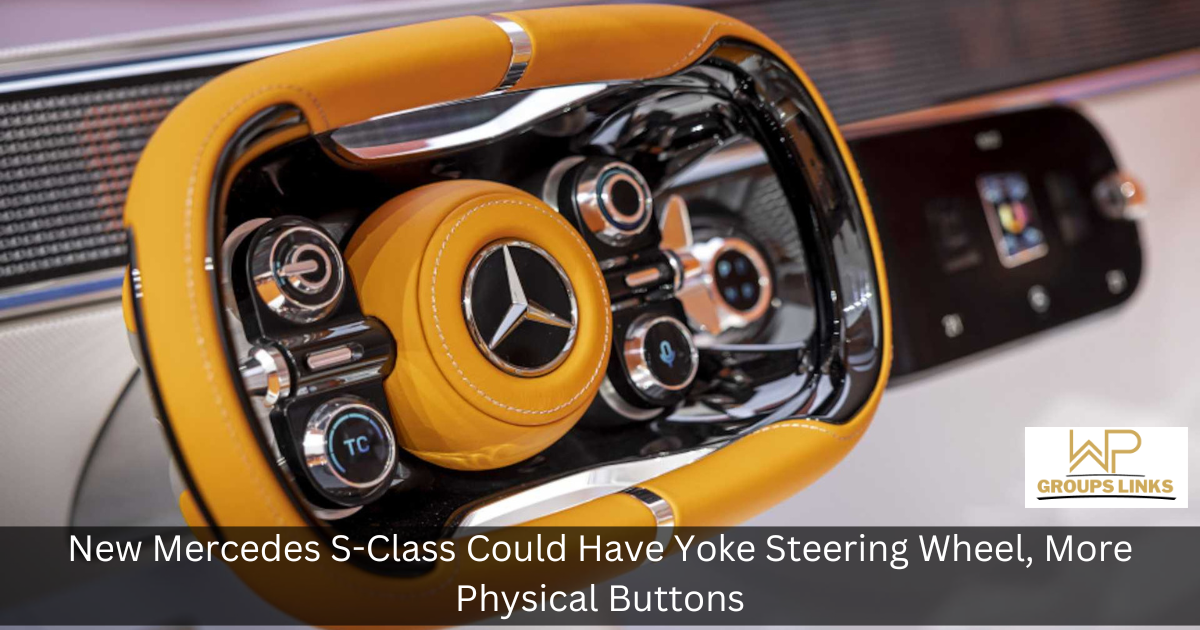Yoke Steering Wheel
The Mercedes S-Class has long been synonymous with luxury, innovation, and cutting-edge technology. As one of the flagship models in the Mercedes-Benz lineup, the S-Class represents the pinnacle of automotive excellence. With each new generation, Mercedes-Benz pushes the boundaries of what is possible in terms of comfort, performance, and safety. In recent rumors and reports, it is suggested that the new Mercedes S-Class could feature a yoke steering wheel and a return to more physical buttons, a departure from the trend towards touchscreens and minimalistic interiors. In this article, we delve into these potential changes and their implications.
The Yoke Steering Wheel:
The concept of a yoke steering wheel is not entirely new to the automotive world. It is a design feature commonly associated with aircraft, where space constraints and the need for precise control make a yoke steering wheel a practical choice. However, the idea of introducing a yoke steering wheel in a luxury sedan like the Mercedes S-Class is a bold move that could redefine the driving experience.

A yoke steering wheel replaces the traditional circular shape with a horizontal grip, resembling the letter “Y.” This design provides a more futuristic and sporty appearance, and it also allows for better visibility of the instrument cluster and central display. Proponents of the yoke steering wheel argue that it offers improved control and ergonomics, especially during spirited driving.
However, there are concerns about the yoke steering wheel’s compatibility with various driving scenarios. Some experts believe that the traditional circular steering wheel design is more intuitive and familiar, particularly during emergency maneuvers or when handing over control to autonomous driving systems. Additionally, drivers accustomed to resting their hands at the bottom of the steering wheel might find the yoke design less comfortable.
A Return to Physical Buttons
In recent years, automotive interiors have seen a shift towards touchscreens and minimalist designs. Many automakers, including Mercedes-Benz, have embraced large, centrally positioned displays that control various vehicle functions. While this approach offers a sleek and modern aesthetic, it has also faced criticism for its potential to create distractions and increase driver workload.

The rumored return of more physical buttons in the new Mercedes S-Class suggests a potential departure from this trend. Physical buttons and switches provide tactile feedback, allowing drivers to operate essential functions without diverting their attention from the road. They can be located by touch, reducing the need for visual focus and minimizing the risk of unintended inputs.
Moreover, physical buttons can offer quicker and more intuitive access to frequently used features. Climate control, audio volume adjustment, and seat adjustments are just a few examples of functions that can be easily controlled through physical buttons. This can enhance the user experience, particularly for older drivers or those who prefer traditional interfaces.
However, striking the right balance between physical buttons and touchscreens is crucial. An excessive number of buttons can clutter the dashboard and create confusion, defeating the purpose of simplicity and ease of use. Automakers must carefully consider the placement, organization, and functionality of physical buttons to ensure they enhance rather than hinder the driving experience.
Implications and Future Outlook
The potential introduction of a yoke steering wheel and increased use of physical buttons in the new Mercedes S-Class signifies a shift towards a more driver-focused and ergonomic approach. By incorporating elements from aviation and embracing tactile controls, Mercedes-Benz aims to create a unique and engaging driving experience that sets the S-Class apart from its competitors.
These changes also reflect a growing recognition of the importance of driver attention and safety. While touchscreens and digital interfaces provide flexibility and customization options, they can demand more cognitive load and increase the risk of distractions. By integrating physical controls, Mercedes-Benz aims to strike a balance between advanced technology and the need for intuitive and easy-to-use interfaces.
From a safety perspective, the yoke steering wheel could offer advantages in terms of improved visibility of the instrument cluster and central display. With the yoke design, drivers may have an unobstructed view of critical information without having to look over or through a traditional steering wheel. However, it remains to be seen how quickly drivers can adapt to the yoke design and whether it proves to be as intuitive and comfortable as the traditional circular steering wheel.
The return to physical buttons also has implications for the user experience and long-term usability of the vehicle. By providing tactile feedback and intuitive operation, physical buttons can enhance the ease of use, especially while driving. Furthermore, physical buttons are less prone to accidental inputs or glitches that touchscreens may encounter. However, automakers must carefully design the layout and functionality of these buttons to avoid cluttering the dashboard and creating confusion for the driver.
Looking ahead, the potential adoption of a yoke steering wheel and increased physical buttons in the new Mercedes S-Class could influence other luxury automakers to follow suit. If these changes prove successful and well-received by consumers, we may see a shift in industry trends, with more manufacturers incorporating similar design elements into their vehicles.
Additionally, advancements in haptic feedback technology could further enhance the usability of touchscreens, mitigating some of the concerns associated with their use. Integrating haptic feedback into touchscreens could provide tactile sensations, simulating the feeling of physical buttons and improving the overall user experience.
The potential introduction of a yoke steering wheel and increased physical buttons in the new Mercedes S-Class represents a departure from current automotive trends. These changes highlight Mercedes-Benz’s commitment to driver attention, safety, and usability. As technology continues to evolve, finding the right balance between advanced interfaces and tactile controls will remain a key challenge for automakers. The future outlook suggests a potential shift towards more driver-focused and ergonomic designs that enhance both safety and user experience in luxury vehicles.
Read More:>
https://wpgroupslinks.com/ai-battles-the-bane-of-space-junk/



